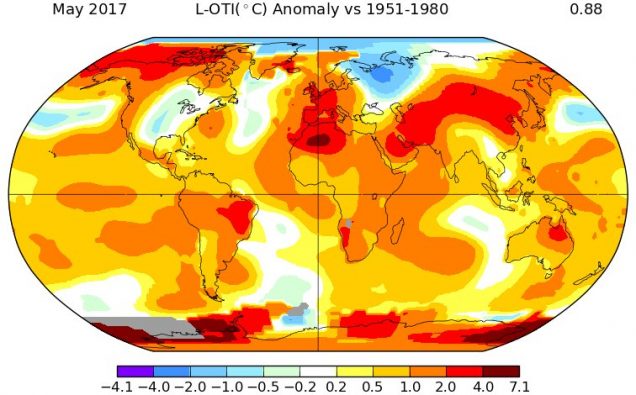
Photo: Official NASA Twitter
There seems to be no end to record heat the world has been experiencing in recent years with May 2017 being reported as the second warmest May in 137 years of modern record-keeping.
A monthly analysis of global temperatures by scientists at NASA’s Goddard Institute for Space Studies (GISS) in New York, reveals that May 2017 was 0.88 degrees Celsius warmer than the mean May temperature from 1951-1980.
The two top May temperature anomalies have occurred during the past two years, with 2016 known as the hottest on record, at 0.93 degrees Celsius warmer than the May mean temperature, the NASA said.
The latest temperature reading come in the middle of a hot debate on the climate change and effects of human industrial activity on the mercury trends.

Arctic Circle (Oct. 2003) — Three Polar bears approach the starboard bow of the Los Angeles-class fast attack submarine USS Honolulu (SSN 718) while surfaced 280 miles from the North Pole. Sighted by a lookout from the bridge (sail) of the submarine, the bears investigated the boat for almost 2 hours before leaving. Commanded by Cmdr. Charles Harris, USS Honolulu while conducting otherwise classified operations in the Arctic, collected scientific data and water samples for U.S. and Canadian Universities as part of an agreement with the Artic Submarine Laboratory (ASL) and the National Science Foundation (NSF). USS Honolulu is the 24th Los Angeles-class submarine, and the first original design in her class to visit the North Pole region. Honolulu is as assigned to Commander Submarine Pacific, Submarine Squadron Three, Pearl Harbor, Hawaii. U. S. Navy photo by Chief Yeoman Alphonso Braggs. (RELEASED)
The debate has intensified as President Donald Trump has indicated that the United States will pull out of the landmark Paris Climate Change Agreement and negotiate another accord that favors the United States.
However, NASA’s latest release of the weather trend for the May has both dimensions. It reports continuing hot weather but a little bit abating of the extreme warming that enveloped regions of the northern hemisphere.
Although May 2017’s temperature was 0.05 degrees Celsius cooler than May 2016, yet it was just 0.01 degrees Celsius warmer than the third warmest May, which occurred in 2014.
The latest land-ocean temperature index anomaly shows that the extreme warmth that affected parts of the northern hemisphere — Siberia in particular — in prior months has partially abated.
According to NASA, the monthly analysis by the GISS team is assembled from publicly available data acquired by about 6,300 meteorological stations around the world, ship- and buoy-based instruments measuring sea surface temperature, and Antarctic research stations.
The world began global temperature recording around 1880 because previous observations didn’t cover enough of the planet.
















